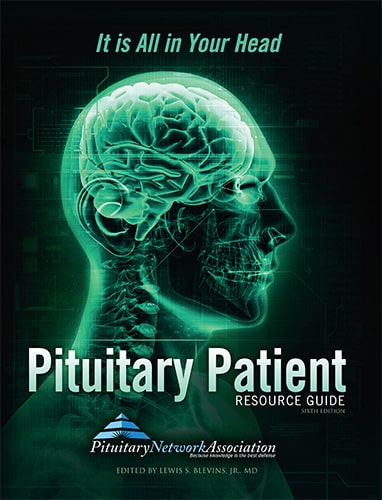News Articles February 2022
Written on 04 February 2022.
News Articles January 2023
Doctor Notices Symptoms of Acromegaly in Patient’s Wife
A story in the Times of India explains how a neurologist, treating a patient for back pain, noticed some changes in the patient’s wife’s face. The wife had accompanied her husband to his appointment, and the doctor noticed that her nose and lips appeared larger, and her teeth more spaced out. He asked if her shoe size had gotten bigger, and when she answered in the affirmative he sent her for tests, which revealed that she had harbored a tumor for two years. he Mayo Clinic has produced a podcast with frequently asked questions on pituitary tumors. Check it out here
Tips on Getting Through Your First Brain MRI
A column in Cushing’s Disease News goes through what to expect during a brain MRI, and how to calm your nerves. Read more:
Does the Pituitary Help People Wake Up Just Before the Alarm?
A story on NPR looks at whether people can train themselves to wake up just before the alarm and the role the pituitary might play. It cites one study from the 90s that did find that when people were expecting to wake up at a certain time, their pituitary released ACTH about an hour before the wake time, which stimulates the adrenals to release cortisol, which helps wake people up.. Read more:
Florida 10-year-old Battles Cancer on Pituitary Gland
A story on CBS Miami follows a 10-year-old girl in Homestead, Florida who is fighting mixed germ cell cancer that is taking over her pituitary gland. Her little brother shaved his head in solidarity. Read more:
Acromegalic, Known as World’s Tallest Man, Turns 40
Acromegalic Sultan Kosen, who is known as the world’s tallest man at 8’3”, has turned 40 . He traveled from Turkey to Orlando to visit an exhibit about Robert Wadlow, who was 8’11” when he passed away at age 22 in 1940. Modern medical advances have helped many acromegalics lead long lives. Read More:
Pituitary Journey: Soccer Star Lionel Messi
An article on News9Live.com explains that international soccer star Lionel Messi suffered from pituitary dwarfism as a child and received growth hormone injections that allowed him to pursue his athletic dreams. Read more:
December 2022 Research Articles – Preview
Pituitary Tumors
Classification Framework for Medical Diagnosis of Brain Tumor with an Effective Hybrid Transfer Learning Model.
Prognostic Factors for Invasiveness and Recurrence of Pituitary Adenomas: A Series of 94 Patients.
Classification of Brain Tumor from Magnetic Resonance Imaging Using Vision Transformers Ensembling.
Radiation Therapy for Recurrent or Residual Pituitary Macroadenoma Invading Extrasellar Structures.
A retrospective cohort study assessing geometrical parameters related to visual deterioration in pituitary macroadenoma
Diagnostic value of magnetic resonance imaging ectopic posterior pituitary hyperintense signal in pituitary macroadenoma.
Proteogenomic landscape and clinical characterization of GH-producing pituitary adenomas/somatotroph pituitary neuroendocrine tumors.
PNA Highlights December 2022

I heard a definition once: Happiness is health and a short memory! I wish I’d invented it, because it is very true.-
-Audrey Hepburn
PNA Spotlight: Dr. Christie Turin More
This month the PNA spotlight shines on Dr. Christie Turin More. Dr. More graduated from the Universidad Peruana Cayetano Heredia Facultad De Medicina Alberto Hurtado in 2013. She works in Aurora, CO and 4 other locations and specializes in Endocrinology, Diabetes & Metabolism and Internal Medicine. Dr More Interned and complete her Residency at Baylor College of Medicine. She received a Fellowship at the Hospital of the University of Pennsylvania. Dr. More answered some questions from the PNA. Here are her answers.

Dr. Christie Turin More
PNA Medical Corner: Pituitary Surgical Technique
This month the PNA Medical Corner showcases a study co-authored by three members of the PNA: Drs. Susan Samson, Kaisorn Chaichana and Alfredo Quinones-Hinojosa of the Mayo Clinic in Jacksonville, Florida. The study found that endoscopic endonasal resection of the medial wall fo the cavernous sinus is associated with better hormonal control later on, but requires advanced surgical skill. Link: https://pubmed.ncbi.nlm.nih.gov/36291288/
Endoscopic Endonasal Resection of the Medial Wall of the Cavernous Sinus and Its Impact on Outcomes of Pituitary Surgery: A Systematic Review and Meta-Analysis
Affiliations expand
- PMID: 36291288 DOI: 3390/brainsci12101354
Abstract:

Dr. Susan Samson

Dr. Kaisorn Chaichana

Dr. Alfredo Quinones-Hinojosa
Copyright © 2024 Pituitary Network Association All rights reserved.
Disclaimer: PNA does not engage in the practice of medicine. It is not a medical authority, nor does it claim to have medical expertise. In all cases, PNA recommends that you consult your own physician regarding any course of treatment or medication.
Our mailing address is:
Pituitary Network Association
P.O. Box 1958
Thousand Oaks, CA 91358
(805) 499-9973 Phone - (805) 480-0633 Fax
Email info@pituitary.org
You are receiving this Newsletter because you have shown interest in receiving information about our activities.
If you do not want to receive any more emails from PNA, Unsubscribe.
December 2022 Research Articles
Pituitary Tumors
Classification Framework for Medical Diagnosis of Brain Tumor with an Effective Hybrid Transfer Learning Model.
Prognostic Factors for Invasiveness and Recurrence of Pituitary Adenomas: A Series of 94 Patients.
Classification of Brain Tumor from Magnetic Resonance Imaging Using Vision Transformers Ensembling.
Radiation Therapy for Recurrent or Residual Pituitary Macroadenoma Invading Extrasellar Structures.
A retrospective cohort study assessing geometrical parameters related to visual deterioration in pituitary macroadenoma
Diagnostic value of magnetic resonance imaging ectopic posterior pituitary hyperintense signal in pituitary macroadenoma.
Proteogenomic landscape and clinical characterization of GH-producing pituitary adenomas/somatotroph pituitary neuroendocrine tumors.
UK practice on incidentally detected non-functioning pituitary microadenomas: analysis of two national surveys during a 12-year interval.
MicroRNA-137 inhibits pituitary prolactinoma proliferation by targeting AKT2.
Post-operative surveillance for somatotroph, lactotroph and non-functional pituitary adenomas after curative resection: a systematic review.
Pituitary Surgery
Approach to the patient – disorders of salt and water balance post pituitary surgery.
Retrosigmoid approach for giant cystic vestibular schwannoma: subperineural dissection technique for facial nerve preservation.
Endoscopic-assisted combined transcrusal anterior petrosal approach for resection of large petroclival meningioma: operative video and nuances of technique.
Editor’s note: Dr. Liu is a longtime member of the PNA
Endoscopic endonasal transclival petroclival meningioma resection.
Editor’s note: Dr. Prevedello is on the PNA Board of Directors.
Contact endoscopy as a novel technique for intra-operative identification of normal pituitary gland and adenoma.
Editor’s note: Drs Gardner and Zononos are members of the PNA.
Cushing’s Disease
How best to monitor the specific side effects of medical treatments of Cushing’s disease.
The Expression of Cell Cycle-Related Genes in USP8-Mutated Corticotroph Neuroendocrine Pituitary Tumors and Their Possible Role in Cell Cycle-Targeting Treatment.
Recommendations for the diagnosis and radiological follow-up of pituitary neuroendocrine tumours.
The lateralization accuracy of inferior petrosal sinus sampling in Cushing’s disease: experiences of a tertiary center.
Acromegaly
May the SAGIT® instrument be used as a preoperative prognostic tool in patients with acromegaly?
Corneal Tonometric and Morphological Changes in Patients with Acromegaly.
The coexistence of newly diagnosed acromegaly with primary empty sella: More frequent than expected?
Pituitary Dwarfism
POU1F1/Pou1f1 c.143-83A > G variant disrupts the branch site in pre-mRNA and leads dwarfism.
Hormonal Health
Deanxit and tandospirone relieved unexplained limb edema in a depressed pituitary adenoma survivor: A case report.
Endocrine system after 2 years of COVID-19 vaccines: A narrative review of the literature.
Heterogeneity of Clinical Manifestations of Hyperprolactinemia (Review and Own Observations).
News Articles December 2022
Pituitary Q & A
The Mayo Clinic has produced a podcast with frequently asked questions on pituitary tumors. Check it out here
Optometrist Spots Signs of Pituitary Tumor; Patient Gets Emergency Surgery
Nonmedical professionals like jewelers, shoe salespersons and optometrists can make a big impact in a patient’s life – by spotting signs of pituitary disease. An article in Insight News tells the story of an extra vigilant optometrist who spotted a red flag, and may have saved a woman’s life. Read more:
Case Study: Keto Diet Alleviates Symptoms of Cushing’s But Delays Diagnosis
An article in Cushing’s Disease News looks at a case study about a man who lost weight on a low carb ketogenic diet, which lessened his symptoms of what turned out to be Cushing’s Disease, but in doing so may have delayed his diagnosis. Read more:
TV Actor Recounts Battle With Pituitary Dwarfism
Actor Max Casella, who has co-starred in shows like “Doogie Howser, MD”,“The Sopranos”, “Boardwalk Empire” and “Tulsa King” talks about growing up with pituitary dwarfism in an article on PageSix.com. He underwent hormone therapy in his twenties to finally jumpstart puberty. Read more:
Can ‘Mini Pituitary Tumors’ Help Improve Treatments?
The website chof360.com looks at A study in the journal Cells looks at efforts by researchers to develop organoids, or organelles – basically cell structures grown in a lab using cells from pituitary surgeries. The study says these mini pituitary tumors mimic the structure of an adenoma, and thus may be useful in developing targeted therapies for Cushing’s patients. Read more:
Why Is It Important To Get The Right TEAM Of Medical And Mental Health Professionals To Help Me In My Treatment?
Pituitary and Neuroendocrine disorders are often complex and difficult to diagnose. A variety of highly skilled doctors who collaborate and communicate about what is in the patient’s best interests is utmost in importance. Often in addition to the endocrinologist, pituitary neurosurgeon, primary care doctor, nurse who is familiar with such disorders, additional professionals such as psychologists and marriage and family therapists may be very helpful and necessary. Treatment not only involves getting a diagnosis (which may take a lot of time and many medical tests), but then deciding with the doctor the best treatment options. Treatments can produce anxiety and fears not only for patients but family members as well. Professionals who collaborate as a team will better be able to understand the unique needs, fears, questions patients and family have, but also be better able to follow patients through the entire process from pre-diagnosis to post critical medical care toward a lifelong plan for optimal health and wellness.
Why Is Early Diagnosis Such A Problem?
The confusing constellation of symptoms that can be produced by pituitary tumors and the difficult to visualize location make diagnosis very tricky. It is not uncommon for patients to have symptoms of either hormonal deficiency (caused by compression of the pituitary or its “stalk”) or hormone excess (caused by unregulated production of hormones by the pituitary tumor). In a significant minority of patients diagnosis is not made until the individual has developed debilitating or life-threatening symptoms of heart disease or adrenal (uncommon), gonadal and/or thyroid insufficiency. Even in the 21st century death from a large pituitary tumor or hormonal deficiency still occurs, albeit rarely. Early diagnosis is usually a reflection of a high index of suspicion on the part of a physician. Unfortunately, many doctors have been taught that pituitary disease is rare, so it is not at the forefront of their list of possible diagnoses.
Are All Pituitary Tumors Created Equal?
No. There are more than a dozen very different disorders that result from pituitary tumors and disease. For example, if a tumor forms in an ACTH secreting pituitary cell, it could result in the overproduction of cortisol (Cushing’s Disease) or the underproduction of cortisol (adrenal insufficiency, often referred to as Secondary Addison’s Disease). Cushing’s is a condition characterized by excessive fat accumulation in central parts of the body (obesity, including a rounded or fat-filled face), diabetes, hypertension, a low serum potassium, thinning and bruising of skin, and osteoporosis. Symptoms of adrenal insufficiency include dehydration, low blood pressure and sodium level, and excessive weight loss. Primary Addison’s Disease is caused when the adrenal glands fail to work on their own, i.e. fail to respond to directions from the pituitary and hypothalamus.
If the tumor forms in a growth hormone producing cell, it can overproduce growth hormone. Tumors that form from growth hormone producing cells cause two different clinical pictures. If they occur in children before the growth plates in long bones have closed, excessive growth hormone will cause gigantism. (Do you recall the movie “My Giant” with Billy Crystal and the basketball player?). If the growth hormone excess occurs during adulthood there is excessive enlargement of the hands, feet, and jaw, as well as soft tissue swelling of many tissues (acromegaly). Acromegaly is associated with an increased probability of developing diabetes mellitus, heart attack, hypertension, and certain types of cancer including malignancy of the colon. Most commonly the facial changes develop subtly and may not be noticed by the patient or his/her family.
How Prevalent Are Pituitary Tumors/Disease?
Autopsy reports and radiologic and MRI evidence from around the globe indicate that one out of every five people worldwide has a pituitary tumor. The earliest study took place in 1936, when Dr. R.T. Costello of the Mayo Foundation conducted a cadaver study and found pituitary tumors in 22.4 % of the population (Costello R.T. Subclinical adenoma of the pituitary gland. Am. J. Pathol. 1936; 12:205-214). Statistics have not changed much ever since. The clinical significance of these findings are critical to determine.
Why Aren’t Pituitary Tumors/Disease Common Knowledge?
- Pituitary tumors/disease present a vast array of symptoms, and it’s often the symptoms that get treated, not the disease. As a result, pituitary patients can spend years being misdiagnosed as their tumors grow. People with undetected pituitary tumors can die of heart attacks, hypothyroidism, adrenal insufficiency or water balance problems, all of which can mask the main cause: a pituitary tumor.
- Dollars spent. As a result, we have failed to answer the most important question: Why are pituitary tumors so common?
- There is a lack of education within the medical community and among the general public.
- The insurance industry hasn’t caught on to the untold billions of dollars that could be saved through early diagnosis and treatment. Once it becomes clear that it’s in everyone’s best interest, the word will spread.
Available Now!

The Pituitary Patient Resource Guide Sixth Edition is now available! Be one of the first to have the most up-to-date information. The Pituitary Patient Resource Guide a one of a kind publication intended as an invaluable source of information not only for patients but also their families, physicians, and all health care providers. It contains information on symptoms, proper testing, how to get a diagnosis, and the treatment options that are available. It also includes Pituitary Network Association's patient resource listings for expert medical care.









